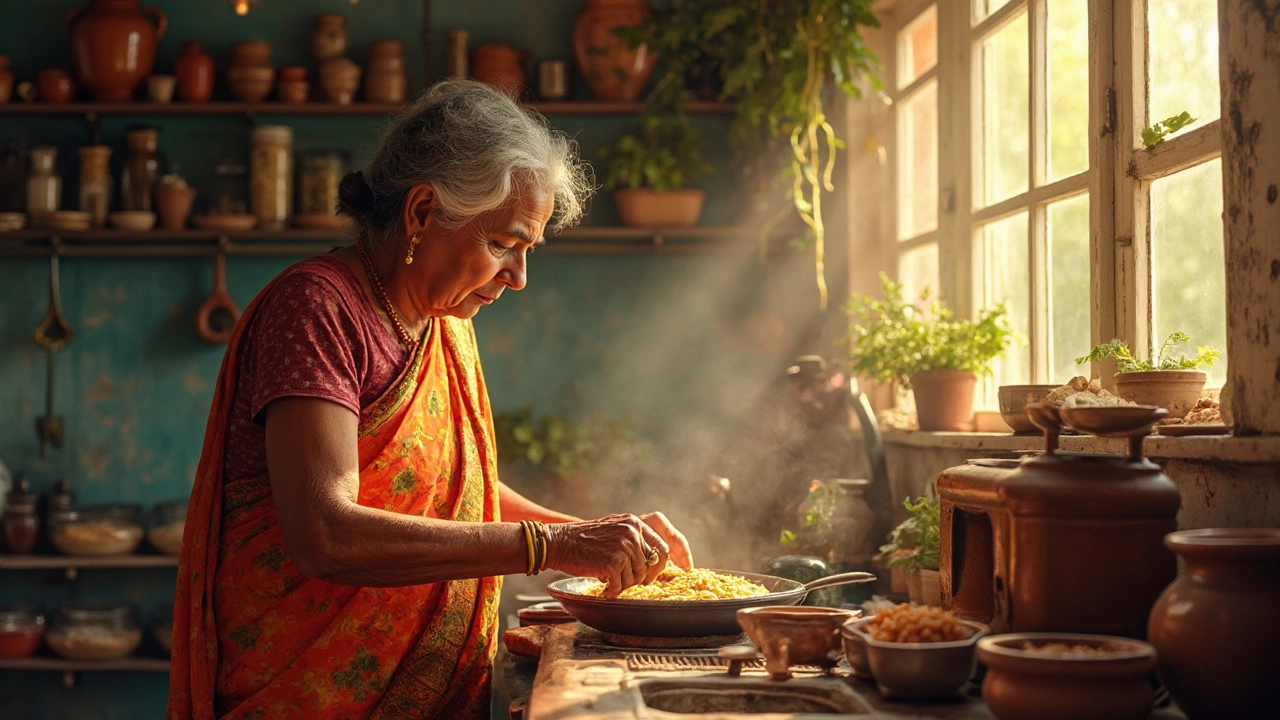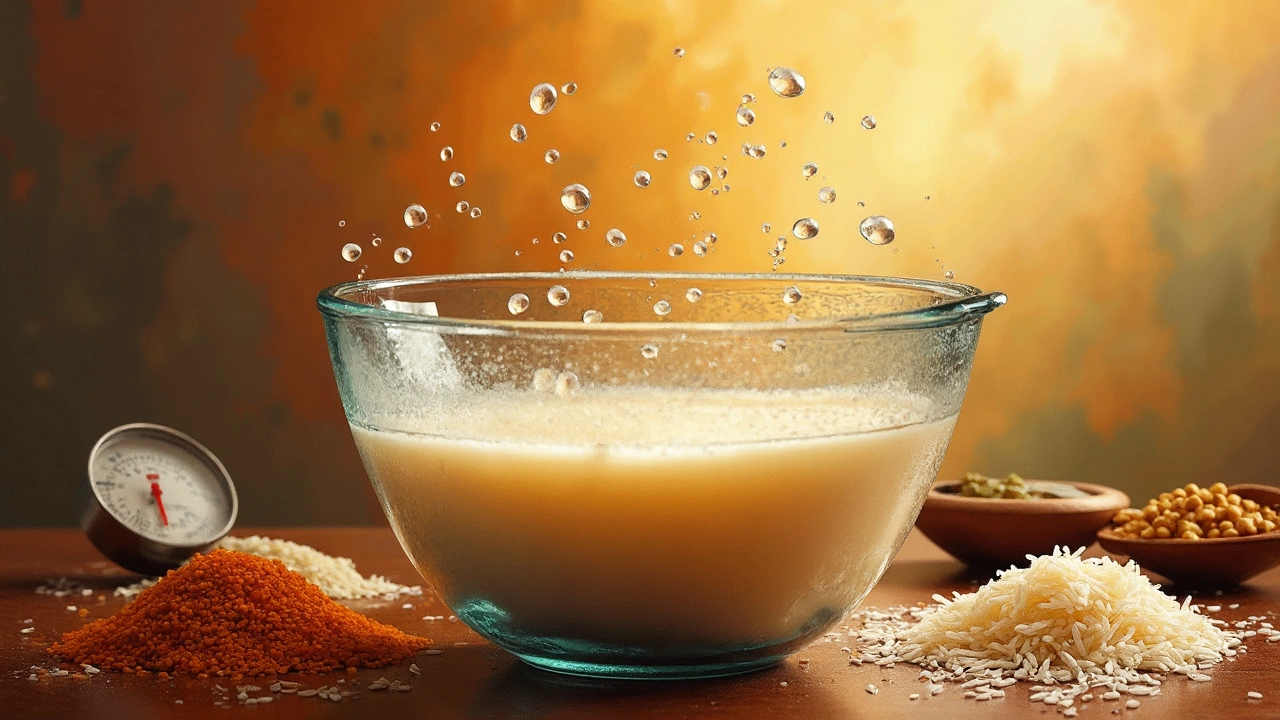Quickly Ferment Dosa Batter Without Yeast: Best Techniques
 Feb, 18 2025
Feb, 18 2025
Who doesn't love a good dosa? Crispy on the outside, soft on the inside – it's a breakfast staple that never goes out of style. But sometimes, waiting for the batter to ferment can feel like forever. So, what's the secret to speeding it up without using yeast?
First things first, understanding your batter is key. You need a blend of rice and urad dal, soaked and ground to smooth perfection. But here's where the magic happens: fermentation. It's all about finding the right environment. Have you tried placing your batter near a warm oven or under the sunlight? A little warmth goes a long way in activating those natural cultures.
- Understanding Dosa Batter Basics
- Temperature Hacks for Fast Fermentation
- Incorporating the Right Ingredients
- Practical Kitchen Tips
- Avoiding Common Pitfalls
- Final Thoughts on Quick Fermentation
Understanding Dosa Batter Basics
Making a perfect dosa starts with getting the basics right. Let's break it down to essentials. The primary ingredients for a classic dosa batter are rice and urad dal (split black gram). But here's the thing: not all rice types give the best results. You want to use a combination of parboiled rice and raw rice to get that ideal texture - crispy yet soft.
Dosa batter fermentation relies heavily on the ratio of ingredients. A popular ratio is 3:1, three parts rice to one part urad dal. This mix strikes the right balance to develop that fermented flavor we're all after.
Choosing the Right Rice and Dal
The two kinds of rice – parboiled and raw – have their roles. Parboiled rice adds texture and crispness, while raw rice helps with binding. As for urad dal, make sure it's fresh. Stale dal can affect the fermentation process, leaving the batter dense and flat, rather than airy.
Grinding the Mixture
Once soaked, the mixture needs to be ground to a smooth paste. Investing some time here is worth it. A good tip is to grind the dal to a frothy, almost fluffy consistency. You can add a splash of water to help it along – but not too much! You're aiming for a semi-thick batter with a pourable consistency.
Salt – The Unsung Hero
Add salt only after the batter has fermented a bit if you're looking to speed things up naturally. It helps control the fermentation process. But remember, too much salt can slow down the quick dosa technique.
Now you know the groundwork for making a dosa batter that heads smoothly into fermentation, keeping you on track for speedy, delicious dosas without a hint of yeast!
Temperature Hacks for Fast Fermentation
Getting your dosa batter fermentation to happen quickly isn't as tricky as it might seem. The right temperature can give your batter a head start, so here's how to make things happen faster.
Utilizing Warm Environments
One simple trick is to put your batter in a warm spot. If you live in a place with a warm climate, letting your batter sit in a sunny area can do wonders. But what if it's chilly outside? No worries, your kitchen can come to the rescue.
- Near Heat Sources: Place the bowl near a cooker or oven that's slightly warm. The little bit of heat can kickstart the fermentation.
- Preheat Your Oven: Switch it on for a moment, let it cool slightly, and then keep your bowl inside (just remember to turn the oven off).
Temperature Boosting Settings
If you've got access to an appliance with a proofer setting, lucky you! This is where the magic really happens:
- Microwave Technique: Just heat a cup of water in your microwave for a minute, remove it, then put in the batter. The warm, steamy environment works its charm!
- Instant Pot Magic: Set it to the yogurt function and relax as it provides a consistent temperature for even fermentation.
Too Cold? No Problem!
When it's too cold, mixing a pinch of sugar into the batter can often help. The sugar fuels the natural bacteria and speeds things up. Just don’t overdo it, or you might end up with sweet dosas!
By using these temperature hacks, you can make sure your batter is ready to roll in hours instead of days. So next time you crave the perfect dosa, you won't have to wait longer than necessary!
Incorporating the Right Ingredients
We talked a little about the basics, but now let's dive into how to turbocharge that dosa batter fermentation with the right ingredients. It's not just about rice and urad dal; the type and quality matter, too.
Choosing the Right Type of Rice
Your go-to should be parboiled rice – it's the MVP when it comes to achieving the perfect fermentation. Why? It retains more nutrients, which feeds the natural yeast in your environment, making your batter fluffier. If you can, avoid using just any old rice. Go for the quality grains!
Urad Dal: Get It Right
Opt for whole urad dal or at least split ones that aren’t polished. The husk in whole dal is a great ally in the fermentation game, helping your batter rise better.
The Secret Ingredient: Fenugreek Seeds
Ever heard of adding a hint of fenugreek seeds? A small handful – think a teaspoon – can boost fermentation. They contain compounds that naturally encourage yeast growth. Plus, they add a subtle aroma to your dosa that’s hard to resist.
Water: The Often-Overlooked Key
Too much seasonal variation can affect water quality. Use filtered water to soak the ingredients for consistent results. Even the water you use can affect how quickly your batter ferments.
Hitting the Right Ratios
| Ingredient | Suggested Ratio |
|---|---|
| Rice | 3 parts |
| Urad Dal | 1 part |
| Fenugreek Seeds | 1 teaspoon per 4 cups of rice |
Caught up with the ratios? A 3:1 ratio of rice to urad dal works wonders for consistency and taste. Deviating from this might yield unexpected results. Getting these ratios right ensures every bit of effort counts, resulting in those perfectly fermented dosas.
Make sure to rinse your rice and dal well before you soak. This small step can help keep unwanted bacteria away and give your batter that extra edge.

Practical Kitchen Tips
If you're itching to make your dosa batter fermentation process quicker, you're in the right place. Let's look at some practical tips that can speed things up right in your own kitchen.
Using Warm Water
One simple trick is using warm water while grinding your rice and urad dal. This not only aids smoother grinding but also gives your batter a head start in the fermentation department. When the batter is slightly warm, those natural cultures multiply faster, leading to quicker fermentation.
Find the Spot
Every kitchen has that perfect warm spot. It might be above the fridge, next to a working oven, or near a window with direct sunlight. A little trial and error can help you find the warmest nook in your kitchen where the magic happens quickest.
Cover it Right
Make sure to cover your batter with a loose-fitting lid or damp cloth. This allows air circulation necessary for the natural organisms to do their work while keeping dust and bugs out.
Adding Fenugreek Seeds
Try tossing a few fenugreek seeds into your batter. These seeds not only boost the nutritional profile but are also known to speed up fermentation, adding a bit more fluffiness to your finished dosas.
Avoid Refrigerating
If you're in a hurry to have fresh dosas, steer clear of the fridge till your batter has had a chance to ferment properly. The cold slows down the process, which is the opposite of what you're aiming for.
With these dosa tips up your sleeve, you can now enjoy homemade dosas even more frequently. Fast, easy, and delicious!
Avoiding Common Pitfalls
When it comes to fermenting dosa batter, a few missteps can seriously slow down the process. Let's make sure you're not falling into these traps!
Don't Skimp on Soaking
A common mistake is not soaking the rice and urad dal long enough. It's tempting to rush, but they need at least 4 to 6 hours. This ensures grains soften, making for smoother batter and facilitating quick dosa technique.
Avoid Over-Diluting the Batter
Adding too much water when grinding leads to a thinner batter, which struggles to rise. You want it to have a thick, scoopable consistency, so watch your water measurements closely.
Temperature Matters
If your kitchen is too cold, fermentation slows down. Keep your batter in a cozy spot, maybe next to a warm appliance or use a slightly preheated oven (turned off, of course!). A temperature of around 30°C (86°F) is ideal for fast results.
Properly Sealed Containers
An airtight container keeps natural bacteria active and prevents unwanted drying, which is essential for effective dosa batter fermentation without yeast. Just remember not to fill the container to the brim, allowing room for batter expansion.
By steering clear of these pitfalls, you set yourself up for the best, fluffiest dosas that are the stuff of legends! And, all without the need for yeast. Enjoy the process and, of course, the delicious end product.
Final Thoughts on Quick Fermentation
When it comes to making dosas, understanding and perfecting quick fermentation is a real game-changer. Sure, it sounds simple, but getting it just right can make all the difference. Whether you're a beginner or a seasoned cook, mastering these techniques ensures no more waiting days for fermenting your batter.
Embrace the Warmth
It all starts with harnessing the power of warmth. Most importantly, remember that a slightly warm environment speeds things up without compromising taste. Using a pre-warmed oven is a practical hack. Just switch it off once warm and pop your dosa batter inside—it works like magic!
A Little Ingredient Magic
While sticking to the essentials is important, sometimes a pinch of sugar or methi seeds can boost fermentation. These ingredients act like metabolism boosters for the batter, helping it rise like the perfect dosa should.
Avoid These Common Blunders
- Too hot or too cold: Extreme temps can either halt or delay fermentation. Aim for that perfect warm balance.
- Overcrowding: Give your batter some breathing room. If crammed, it may not ferment evenly.
- Skipping the salt: Not only does salt enhance flavor, but it also plays a minor role in fermentation. Don’t forget it!
And there you have it! With these insights and tips, you can make your dosa batter ferment faster and serve those spicy, coconut-chutney-laden dosas without the long wait.
Fast fermentation is not a myth as long as you follow these simple science-backed tips. Now, go ahead and enjoy whipping up those perfect, crispy serendipities whenever you fancy!